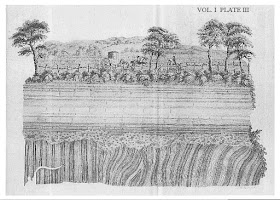On my trip down the Dry Cimarron River, across the High Plains, and then on to the Cimarron proper, I often saw vegetation brand new to me but apparently common in New Mexico. From a distance I thought it was grassland with heavy shrub cover, maybe mesquite. But soon the distinctive form of the “shrubs” was obvious: thickish stems, awkward branching, no leaves. These were cacti.
 |
|
Dry Cimarron valley, land of cacti and clastic plugs (mid photo).
|
The cactus was unfamiliar, but easy to identify: Cylindropuntia imbricata, tree cholla. It’s large, three to seven feet tall, even 10 or 15 under favorable conditions. Often there’s a short “trunk” that soon branches. Spines are sparse, revealing green jointed stems. The yellow fruits stay on the plants through the off season. The most helpful features are the tubercles—bumps on the stems bearing specialized buds (areoles) that produce spines (more here). Cactus tubercles are usually described as “small rounded projections” but those of the tree cholla are large and elongate. The sparse spines make them easy to spot.
 |
|
Yellow fruit from previous year still on plants in early May.
|
 |
|
Stems are sometimes reddish in winter.
|
 |
|
Prickly pear cactus (Opuntia polyacantha) has “small rounded” tubercles.
|
 |
|
Distinctive elongate tubercles of the tree cholla.
|
Being a veg ecologist of the American West, I was suspicious of these cholla fields. Heavy shrub cover in grassland often indicates over-grazing. Livestock almost always prefer grass to shrubs, giving the shrubs a competitive advantage that can lead to dominance. How about tree chollas? Surely no cow or sheep would eat one if grass were available.
 |
|
Grassland thick with tree chollas, Dry Cimarron Valley (with ghosts of travelers past).
|
 |
|
Tree cholla grassland on the High Plains north of Clayton.
|
 |
|
Tree chollas, just west of Cimarron.
|
Back at home, I looked for tree cholla vegetation types in the US National Vegetation Classification. I found a good match: Opuntia imbricata Ruderal Shrubland (Opuntia is a synonym for Cylindropuntia). My suspicions were confirmed:
Now the inevitable counter-questions: What about bison (buffalo)? There was a time not all that long ago when bison numbering in the millions roamed the American West, including New Mexico. What did these grasslands look like then? How common was tree cholla? Did bison eat it as readily as grass? The answer: we don’t know and probably never will (add these to life’s persistent questions).“This anthropogenic (semi-natural) shrubland results from overgrazing of native grasslands. It occurs particularly in slightly moister settings along broad swales. Infestation of Opuntia imbricata [synonym for Cylindropuntia imbricata] is variable, and cover of Opuntia in this type ranges from 25% to nearly 100%. Grass cover and composition is highly variable, depending on site and grazing regime and history. This broadly defined community grades to grassland (often with some Opuntia cover) or to other grazing-induced shrubland communities, such as those dominated by Prosopis, Acacia, and/or Mimosa” [shrubs in the pea family] (NatureServe Explorer).
But these questions are irrelevant where tree cholla has been introduced. It’s now widely naturalized—in eastern and southern Europe, northern and southern Africa, southern South America, and eastern Australia, often to the detriment of grasslands. For example, in Queensland, it threatens native semi-arid grasslands, and has been listed as a priority environmental weed (source).
Ironically, while land managers try to find a way to eradicate tree cholla (e.g., fire, chaining, chemicals), gardeners are encouraging it. “C. imbricata is one of the best chollas for desert landscaping. … It is an attractive plant in desert gardens, and cultivation is quite easy” [for the same reason it’s so hard to eradicate in pastures]. “All you have to do is plant one of the ten-twelve-inch stems in the ground. Water it after it has a chance to put out roots, in a few weeks.” Saguaroland Bulletin v.30:no.1-10 (1976)
Ironically, while land managers try to find a way to eradicate tree cholla (e.g., fire, chaining, chemicals), gardeners are encouraging it. “C. imbricata is one of the best chollas for desert landscaping. … It is an attractive plant in desert gardens, and cultivation is quite easy” [for the same reason it’s so hard to eradicate in pastures]. “All you have to do is plant one of the ten-twelve-inch stems in the ground. Water it after it has a chance to put out roots, in a few weeks.” Saguaroland Bulletin v.30:no.1-10 (1976)
 |
| Summer flowers (NPS). |
Tree cholla is not restricted to desert gardens. It has long been grown in Europe, though not without challenges:
“It is the commonest member of the group to which it belongs in European gardens, and was first introduced to cultivation in the earlier years of the nineteenth century. In spite of this, however, it is a plant whose flowers, which are very attractive but which will only expand under the influence of direct sunshine and unfortunately do not last long, are not often seen in the United Kingdom. Sir Edmund Loder informs us that his example at Leonardslee has but seldom flowered; when it did so in 1908 this happened during a time of very hot, sunny weather, and individual flowers only remained fully open during one afternoon, from about midday till sunset.” Curtis’s Botanical Magazine v. 135; 1909
 |
| Curtis's Botanical Magazine, 1909 (courtesy Biodiversity Heritage Library). |
































